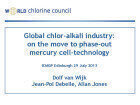Hazardous Waste
The global chlor-alkali industry on the move to phase-out mercury cell technology
Feb 03 2014
Author: Dolf van Wijk on behalf of Euro Chlor
Chlorine was discovered in 1774 and was produced on industrial scale since end of the 19th century. Usual co-products of chlorine are caustic soda (NaOH) and hydrogen gas. One of the earliest and most widely known benefits of chlorine was the ability to disinfect drinking water and thereby gaining major advances in controlling waterborne diseases, as recognized by WHO. Nowadays chlorine use for disinfection is only a small fraction and chlorine has become a highly versatile building block for many different chemical products. It is hard to think of any current product which is not made with the help of chlorine at some stage of its production.
Currently, most of the chlorine is produced on an industrial scale in three different ways, of which mercury electrolysis cells is one of the oldest and on its way to phase out. The period 2002-2011 showed a decrease of 42% in number of plants using mercury cell technology and in mercury-cell based capacity, which is now less than 5.3 million t/yr. Over the same period the mercury emissions went down by 73% and is currently less than 7 t/yr, which represents less than 1% of total mercury emissions worldwide.
Mercury technology is the least efficient technology in terms of environmental performance and energy use. The fact that mercury technology is still applied is solely for economic reasons. Investments in chlor-alkali production plants are typically long-term and early decommissioning therefore has significant asset depreciation and investment cost implications. Secondly, if no additional benefits are available, the economic (energy) advantages of membrane versus mercury cell technology still have a pay-back time of more than ten years. This was shown in a UNEP Partnership report on economics of conversion which was based on a number of case studies (UNEP - Economics of Conversion). If specific circumstances apply, such as capacity extension driven by increased market demand or other advantages, the pay-back time can be significantly reduced. Nevertheless, the downward trend of mercury cell capacity will continue as existing facilities reach the end of their economic life, electricity prices keep rising and/or market opportunities occur. In addition there are regional voluntary commitments with phase-out deadlines, for example by 2020 in Europe.
In the transition period the chlor-alkali industry, through the World Chlorine Council (WCC) representing 90% of the global production capacity, continues to develop and promote cleaner procedures for mercury-cells operation through information exchange and benchmarking. Best practices on safe handling during production, decommissioning and storage and reduction of releases and exposure are also exchanged through the UNEP Partnership.
Events
Apr 22 2024 Hannover, Germany
Apr 23 2024 Kuala Lumpur, Malaysia
Apr 24 2024 Sao Paulo, Brasil
May 05 2024 Seville, Spain
May 13 2024 Munich, Germany










